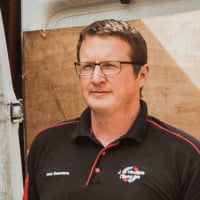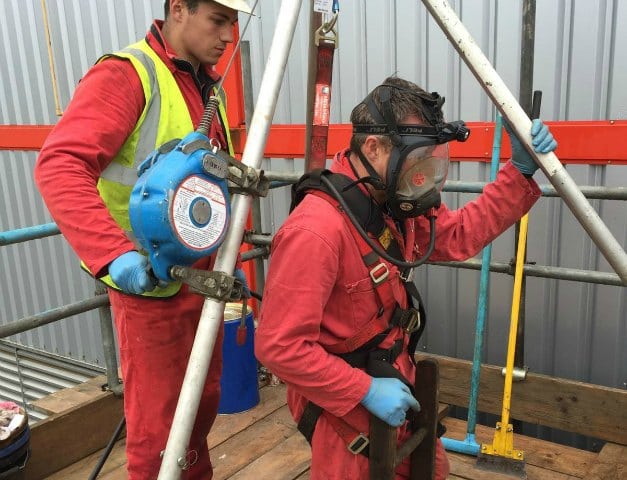Petrol Tank Cleaning – A Guide
The object of this article is to present to you a petrol tank cleaning guide, why they are necessary and what’s involved. It must be recognised that any works on fuel and oil tanks should be carried out by a competent and experienced contractor. The contractor should adopt practices in line with guidance such as ‘Design, Construction, Modification, Maintenance and Decommissioning of Filling Stations (4th Edition), OFTEC Technical Book 3, HSE Guidance and Best Practice and all legal duties set out under the Health and Safety at Work Act 1974.
Service Overview
At JWH Tanks Ltd. tank cleaning is a fundamental part of our business. It is the most common task completed for our customers. All tank cleaning is carried out by our in house team and is tailored to your needs.
Why Have Your Petrol Tank Cleaned?
The main reason for a tank clean is to prevent contaminination of your fuel stock. Sludge, sediment and other materials can often be found at the bottom of petrol tanks and in turn, affect your supply. Condensed water and microbes such as bacteria and fungi are generally the most common causes of fuel contamination. In turn, generate many issues, incuding:
- Blocked filters
- Sediments in filters
- Fuel discolouration
- Corrosion in the fuel tank
Petrol Tank Cleaning – The Process
When delivering our tank cleaning service to you, preparing a safe system of work is vital. We will tailor our risk assessment and method statement to your needs and ensure the correct equipment is brought for the job. A site survey may be necessary in order to assess the project. This allows us to ensure our engineers health and safety is priority, as well as giving you peace of mind a complete cleaning solution is offered.
Ideally, your petrol stock would be run down as much as possible before we arrive. Remaining fuel would then be pumped out using commercial pumps and suction lines into IBC’s or alternative fuel storage tank. Confined space entry permits are always sought prior to entering a tank, in line with maintaining a safe system of work. Working from height is also used if the work requires.
To clean and recommission a petrol tank, we need safe access and egress. Rectangular tanks often have manhole entry points on top of the tank. This allows a rescue tripod to be erected above the entry point with an operative hooked onto the safety line, as well as a entry controller monitoring the operative inside the tank. Cylindrical tanks are slightly more complicated due to a tripod not being able to sit on top. In this situation, scaffolding can be employed. With our large network, we can employ an accredited scaffold provider to construct a temporary platform, allowing us entry into the tank.
Once Inside
Before an operative enters a tank, they would have full breathing apparatus on and connected to an airline. Ventilation of the tank takes place before our engineer would enter. Atmospheres with a concentration of flammable vapors at or above 10 percent of the lower explosive limit (LEL) are considered hazardous when located in confined spaces. Therefore, we are constantly monitoring this with our gas detecters. The reasoning for this, is because the fuel/air mixtures present in petrol is extremely volatile due to the fuels vapours. This would make breathing without breathing equipment deadly.
Equipment such as non sparking scrapers (made from brass) and squeegees are utilised to break stubborn sludge and grit off the tank walls and floor. A commercial vacuum is then used to suck the debris up. If there are any solids in the tank then a plastic spade can be used to shovel out and debris. Degreaser is often introduced to a petrol tank clean to aid the operative in breaking down hard to shift sludge, followed by water to help rinse the tank down. The operative will then proceed to rag the tank dry, so moisture is at a minimum before the fuel stock is added back in. Photographs are provided to the customer and later added to a job card, they are then sent with any other documentation the customer requires.
If the tank is above ground, we will supply new bolts to close the hatch. If the tank is underground new gasket can be put on the flange if the customer wishes.
The process of a diesel tank clean varies. Typically a day will suffice, but does depend on the size of the tank being worked on. We strive to minimise any disruption to your business.
J. W. Hinchliffe (Tanks) Ltd
As a company, J W Hinchliffe (Tanks) Ltd have specialised in fuel and oil tank decommissioning for nearly 50 years. Using our own in-house team, we can offer a bespoke service to meet the needs of any client, from transport operators, to the construction and public sectors. If you would like to know more about the services we offer, please see our services page. If you would like to contact us directly, you can email [email protected] or call directly on 01132635163 where you can speak immediately to an experienced tank decommissioning engineer.
All of our work is carried out in line with current best practice and legislation. You can read more industry news through organisations such as the APEA (Association for Petroleum & Explosives Administration) by clicking here.
You can follow us across our many social media channels here – Linkedin, Instagram and Facebook

